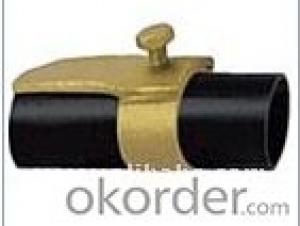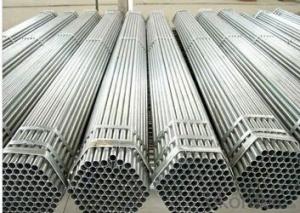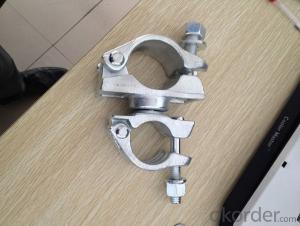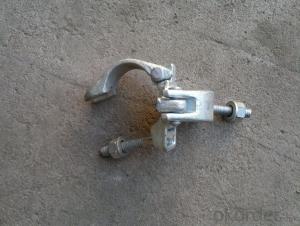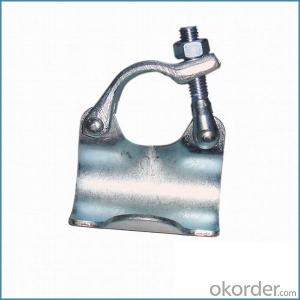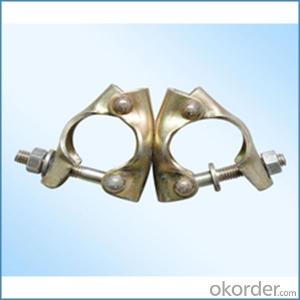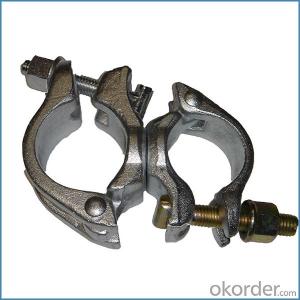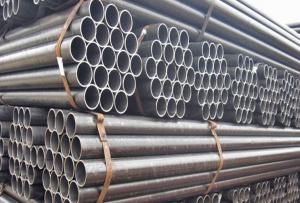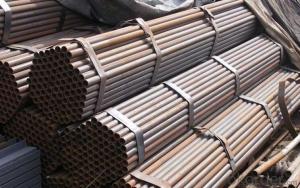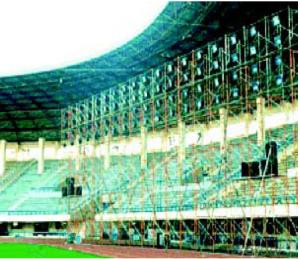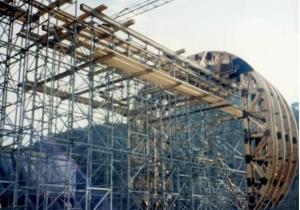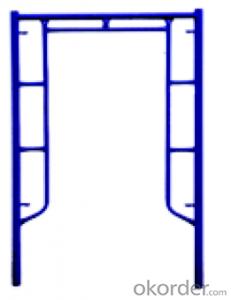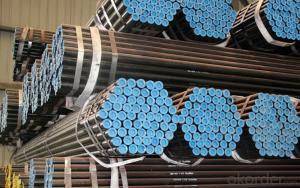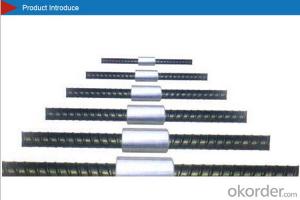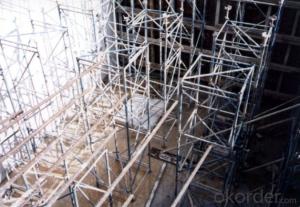Scaffolding putlog head couplers
- Loading Port:
- China Main Port
- Payment Terms:
- TT OR LC
- Min Order Qty:
- -
- Supply Capability:
- -
OKorder Service Pledge
OKorder Financial Service
You Might Also Like
Quick Details
| Place of Origin: | Model Number: | ||||
| Type: | Material: | Surface: | |||
| Color: | Size: | Weight: | |||
| Technics: | Standard: | scaffolding coupler: | |||
| Stable: |
Packaging & Delivery
| Packaging Detail: | in bulk or pallet according to customer's requirement |
| Delivery Detail: | no more than 20days |
Specifications
Best price scaffolding putlog head
Good bearing capacity .
Used time long .
Very good stability .
Covenient to transport
Scaffolding coupler
1.have our own factory
2.Good bearing capacity
3.Stable& durable
4.Easy to assemble or dismantle
Our capability
Produce Equipment: 4 forged production lines,2assembly line,2 bolish line ,1sets 400 punch press,3sets 300t punch press
Produce Technology: stamping/pressing/forging;
Produce Capacity: 500 tons/month
Output: 3000 pcs/day couplers,3000pcs steel plank
Specification
Scaffolding putlog head
1.size:48.3mm
2.weight:0.6kg
3.Material: Q235/225/345
4.surface :self-color / zinc plate / electro galvanized / HDG or painted
5.Standard: EN74 ,BS1139
6.Anti-rust ,skidproof ,high breaking strength
7.Durable finish, reliability, low maintenance, corrosion resistance, robust construction and high tensile strength
8. OEM serice is available
- Q:Can steel tube couplers be used in scaffolding projects with limited overhead clearance due to existing structures?
- Scaffolding projects with limited overhead clearance due to existing structures can utilize steel tube couplers. These couplers are specifically designed to connect steel tubes, enabling the creation of scaffolding structures. Their versatility allows for various configurations, making it possible to construct scaffolding systems that can fit into tight spaces. When faced with limited overhead clearance, steel tube couplers are the ideal solution to construct a scaffolding system that fits within the available space while providing the required support and stability. To ensure safety and compliance with local regulations, it is crucial to have a qualified professional properly design and install the scaffolding system.
- Q:How do you properly install and secure steel tube couplers in scaffolding?
- To ensure the stability and safety of the structure, it is crucial to properly install and secure steel tube couplers in scaffolding. Follow this guide to accomplish the task: 1. Begin by thoroughly examining the steel tubes and couplers for any signs of damage or defects. Confirm that they are in good condition, devoid of cracks or deformities. 2. Determine the appropriate placement and alignment of the couplers on the steel tubes. Use measurements to mark the desired location for each coupler. 3. Apply a thin layer of anti-seize compound or lubricant to the interior of the coupler. This will facilitate easy installation and prevent corrosion between the steel tube and coupler. 4. Slide the coupler onto the steel tube, aligning it with the marked location. Ensure that the coupler is securely seated on the tube, leaving no gaps. 5. Firmly tighten the coupler using a scaffold spanner or wrench. Ensure a secure fit, avoiding excessive tightening that could cause damage. Follow the manufacturer's recommendations for the recommended torque or tightening specifications. 6. Inspect the installed coupler to confirm proper alignment and secure attachment to the steel tube. Verify that there are no visible gaps or movement between the tube and coupler. 7. Repeat the above steps for all other couplers that need to be installed in the scaffolding structure. 8. Once all couplers are installed, evaluate the overall stability and integrity of the scaffolding. Confirm that all joints are secure and there is no noticeable movement or wobbling. 9. Regularly inspect the scaffolding during use to ensure the continued secure fastening of the couplers. Immediately replace any loose or damaged couplers to maintain the safety of the scaffolding structure. It is important to note that these steps offer a general guideline for installing and securing steel tube couplers in scaffolding. It is always advised to consult the manufacturer's instructions and guidelines specific to the couplers and scaffolding system being used. Additionally, it is essential to adhere to all relevant safety regulations and standards to ensure proper installation and securement of these couplers in scaffolding.
- Q:Are there any specific guidelines for the safe use of steel tube couplers in scaffolding near confined spaces or trenches?
- Yes, there are specific guidelines for the safe use of steel tube couplers in scaffolding near confined spaces or trenches. Firstly, it is important to ensure that the scaffolding is designed and erected by competent personnel who have the necessary knowledge and experience. The scaffolding should be inspected and approved by a competent person before it is used. When working near confined spaces or trenches, it is essential to assess the risks associated with the specific area. This includes considering factors such as the stability of the ground, the presence of underground utilities, and the potential for collapse or engulfment. To mitigate these risks, additional precautions should be taken. This may include providing additional bracing or supports to the scaffolding structure, using guardrails and toe boards to prevent falls, and implementing a permit-to-work system to control access to the confined space or trench. Furthermore, it is important to ensure that all workers are trained in the safe use of steel tube couplers and scaffolding equipment. They should be familiar with the manufacturer's instructions and guidelines for assembly, disassembly, and use. Regular inspections and maintenance of the scaffolding and couplers should also be conducted to identify any defects or damage that could compromise safety. Any issues should be promptly addressed and rectified. Finally, it is crucial to have an emergency plan in place in case of an incident or accident. This plan should include procedures for evacuating workers, providing first aid, and contacting emergency services. By adhering to these guidelines, the safe use of steel tube couplers in scaffolding near confined spaces or trenches can be ensured, minimizing the risks to workers and maintaining a safe working environment.
- Q:What are the maximum allowable tolerances for steel tube coupler connections?
- The maximum allowable tolerances for steel tube coupler connections depend on various factors such as the specific application, industry standards, and regulatory requirements. However, in general, the maximum allowable tolerances for steel tube coupler connections typically include considerations for dimensional tolerances, alignment tolerances, and surface condition tolerances. Dimensional tolerances refer to the allowable variation in the dimensions of the coupler and the tube. These tolerances ensure that the coupler and tube can be properly fitted together without significant gaps or misalignment. The specific dimensional tolerances may vary depending on the size and type of the coupler and tube, but typically they are expressed as a percentage or a specific measurement range. Alignment tolerances are crucial for ensuring the proper alignment and positioning of the coupler connection. They specify the acceptable angular deviation or misalignment between the connected tubes. The alignment tolerances can be specified in terms of degrees or as a maximum allowable gap between the tubes. Surface condition tolerances relate to the quality and condition of the surfaces that come into contact during the coupler connection. They outline the permissible surface roughness, imperfections, and defects on the coupler and tube surfaces. These tolerances ensure that the connection remains structurally sound and can withstand the intended loads and environmental conditions. It is important to note that specific industries, such as construction or oil and gas, may have their own standards and guidelines that define the maximum allowable tolerances for steel tube coupler connections. Therefore, it is recommended to consult relevant industry standards or regulatory bodies to obtain the most accurate and up-to-date information regarding the maximum allowable tolerances for specific applications.
- Q:Are there any specific guidelines for the safe use of steel tube couplers in scaffolding systems with overhead hazards?
- Yes, there are specific guidelines for the safe use of steel tube couplers in scaffolding systems with overhead hazards. Here are some key guidelines to follow: 1. Proper inspection: Before using steel tube couplers, they should be inspected thoroughly for any signs of damage or corrosion. Any coupler that is damaged or shows signs of wear and tear should be immediately replaced. 2. Load capacity: It is crucial to know and understand the load capacity of the steel tube couplers. Make sure to use couplers that are rated to handle the expected load, including any additional weight due to overhead hazards. 3. Secure connections: Ensure that all steel tube couplers are properly connected and tightened to provide a secure and stable scaffolding structure. Loose or improperly connected couplers can lead to instability and accidents. 4. Overhead hazards assessment: Before erecting scaffolding with steel tube couplers, conduct a thorough assessment of the overhead hazards in the work area. This may include identifying potential falling objects, overhead equipment, or other obstructions that could pose a risk to the scaffolding system. 5. Protective measures: Implement adequate protective measures to prevent overhead hazards from causing accidents. This may involve installing overhead protection systems such as debris nets, catch platforms, or toe boards. 6. Proper training: Ensure that all workers involved in scaffolding operations with steel tube couplers are properly trained in their safe use. This includes training on how to inspect, assemble, and dismantle the scaffolding, as well as how to respond in the event of an overhead hazard. 7. Compliance with regulations: Follow all relevant safety regulations and standards regarding the use of steel tube couplers in scaffolding systems. These regulations may vary depending on the jurisdiction, so it is essential to stay updated with the latest guidelines. By following these specific guidelines, you can enhance the safety of scaffolding systems using steel tube couplers in environments with overhead hazards and minimize the risk of accidents or injuries. It is always recommended to consult with a qualified scaffolding professional or safety expert for specific guidance based on your unique worksite requirements.
- Q:Are steel tube couplers suitable for scaffolding projects with limited space?
- Yes, steel tube couplers are suitable for scaffolding projects with limited space. Steel tube couplers are compact and versatile, allowing for easy assembly in tight spaces. They are designed to securely connect steel tubes, providing a strong and stable structure for scaffolding. Additionally, steel tube couplers offer flexibility in adjusting the height and configuration of the scaffolding, making them ideal for projects with limited space where precise positioning is required.
- Q:What are the common sizes and dimensions of steel tube couplers for scaffolding?
- The sizes and dimensions of steel tube couplers for scaffolding differ depending on the type of coupler and the region in which it is utilized. However, there are industry-standard sizes and dimensions that are commonly encountered. For fixed couplers, which are employed to connect two tubes at right angles, the most prevalent outer diameter is 48.3mm. This size is extensively utilized worldwide and is considered standard for scaffolding construction. The length of the coupler is typically around 80-90mm, providing ample space for securely connecting the two tubes. Swivel couplers, which enable the connection of two tubes at any angle, also possess a similar outer diameter of 48.3mm. The length of a swivel coupler is usually slightly longer than that of a fixed coupler, ranging from 90-100mm. This additional length is necessary to accommodate the swiveling mechanism, which allows for flexibility in the angle of connection. In addition to these standardized sizes, there may be variations in dimensions based on the specific manufacturer or regional preferences. It is crucial to ensure that the couplers employed in a scaffolding project adhere to the relevant safety standards and regulations in the respective area of usage. Seeking guidance from local experts or referring to industry guidelines can help ensure the correct sizes and dimensions are selected for a scaffolding project.
- Q:How do steel tube couplers prevent unwanted movement or shifting of scaffolding components?
- To prevent the undesired movement or shifting of scaffolding components, steel tube couplers are employed. These couplers establish a secure and inflexible connection between the tubes by tightly grasping them and keeping them in place, thereby preventing any lateral or vertical motion. The construction of steel tube couplers plays a significant role in achieving this objective. Typically crafted from high-strength steel, these couplers possess the ability to withstand substantial loads and ensure stability. By fitting closely around the tubes, they create a firm and dependable connection. Moreover, steel tube couplers often incorporate locking mechanisms or bolts that can be tightened to further fortify the connection. This feature guarantees that the scaffolding components remain securely fixed, even when subjected to dynamic loads or external forces. Additionally, steel tube couplers offer a consistent and uniform connection between scaffolding components. This aids in the even distribution of the load across the entire structure, minimizing the risk of localized stress concentrations or weak points that could trigger unwanted movement or shifting. In summary, steel tube couplers are indispensable for upholding the stability and safety of scaffolding systems. They provide a dependable and rigid connection between the tubes, effectively preventing any undesired movement or shifting of the scaffolding components.
- Q:What are the requirements for inspecting steel tube couplers in scaffolding?
- Inspecting steel tube couplers in scaffolding involves a comprehensive examination to guarantee their safety and stability. Several key requirements include: 1. Visual Inspection: Inspectors must visually assess each steel tube coupler for visible damage or signs of wear and tear. This entails checking for cracks, deformations, rust, or any indications of structural compromise. 2. Verification of Load Capacity: Inspectors are responsible for ensuring that the steel tube couplers can safely support the intended load. This may involve verifying the couplers' load capacity and cross-referencing it with the weight of the scaffolding components and equipment to be used. 3. Proper Fit and Alignment: Inspectors should confirm that the steel tube couplers fit securely onto the scaffolding tubes and are properly aligned. Any loose or misaligned couplers should be identified and rectified to ensure a secure connection. 4. Labeling and Identification: It is crucial to ensure that all steel tube couplers are appropriately labeled and identified, indicating their load capacity, manufacturer, and any specific instructions or limitations. Inspectors should ensure that the labeling is clear and legible. 5. Regular Maintenance and Inspections: In addition to initial inspections, regular maintenance and periodic inspections should be conducted to ensure ongoing safety and performance. Inspectors should establish a maintenance schedule and ensure that all steel tube couplers are inspected and maintained according to the manufacturer's recommendations. 6. Compliance with Relevant Standards: Inspectors must verify that the steel tube couplers comply with relevant industry standards and regulations, such as those set by the Occupational Safety and Health Administration (OSHA) or local building codes. Compliance with these standards ensures that the couplers meet minimum safety requirements. Overall, the inspection requirements for steel tube couplers in scaffolding aim to guarantee the structural integrity, load capacity, and overall safety of the scaffolding system. By conducting thorough inspections and adhering to these requirements, potential hazards or risks associated with faulty or compromised couplers can be minimized, promoting a safe working environment.
- Q:Ok well I have been planning on getting a scaffold/industrial and I was reading some questions that others asked and alot of people said a 13 year old wouldn't be able to get one because they are to young, even with a parents consent! Is this true?
- your bod is still growing until 21-25 yrs and why ruin perfection like you all the best
1. Manufacturer Overview |
|
|---|---|
| Location | |
| Year Established | |
| Annual Output Value | |
| Main Markets | |
| Company Certifications | |
2. Manufacturer Certificates |
|
|---|---|
| a) Certification Name | |
| Range | |
| Reference | |
| Validity Period | |
3. Manufacturer Capability |
|
|---|---|
| a)Trade Capacity | |
| Nearest Port | |
| Export Percentage | |
| No.of Employees in Trade Department | |
| Language Spoken: | |
| b)Factory Information | |
| Factory Size: | |
| No. of Production Lines | |
| Contract Manufacturing | |
| Product Price Range | |
Send your message to us
Scaffolding putlog head couplers
- Loading Port:
- China Main Port
- Payment Terms:
- TT OR LC
- Min Order Qty:
- -
- Supply Capability:
- -
OKorder Service Pledge
OKorder Financial Service
Similar products
New products
Hot products
Hot Searches
